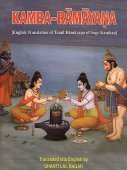Adikavi, Ādikavi, Adi-kavi: 9 definitions
Introduction:
Adikavi means something in Hinduism, Sanskrit, Marathi. If you want to know the exact meaning, history, etymology or English translation of this term then check out the descriptions on this page. Add your comment or reference to a book if you want to contribute to this summary article.
Languages of India and abroad
Marathi-English dictionary
Source: DDSA: The Molesworth Marathi and English Dictionaryādikavi (आदिकवि).—m (S) The first poet. A designation of brahmadēva & of valmīka, and then of vyāsa &c. Hence, used, appellatively, in high praise.
Source: DDSA: The Aryabhusan school dictionary, Marathi-Englishādikavi (आदिकवि).—m The first poet. The designa- tion of bramhadēva, vālmīka, vyāsa, &c. Hence used as an appellation of high praise.
Marathi is an Indo-European language having over 70 million native speakers people in (predominantly) Maharashtra India. Marathi, like many other Indo-Aryan languages, evolved from early forms of Prakrit, which itself is a subset of Sanskrit, one of the most ancient languages of the world.
Sanskrit dictionary
Source: DDSA: The practical Sanskrit-English dictionaryĀdikavi (आदिकवि).—'the first poet', an epithet of Brahmā and of Vālmīki; the former is so called because he first produced and promulgated the Vedas; (tene brahma hṛdā ya ādikavaye muhyanti yatsūrayaḥ Bhāgavata 1.1.1.) and the latter, because he was the first to show to others 'the path of poets'; when he beheld one of a pair of Krauñcha birds being killed by a fowler, he cursed the wretch, and his grief unconsciously took the form of a verse (ślokatvamāpadyata yasya śokaḥ); he was subsequently told by Brahmā to compose the life of Rāma, and he thus gave to the world the first poem in Sanskrit, the Rāmāyaṇa; cf. Uttararāmacarita 2. Viṣkambhaka.
Derivable forms: ādikaviḥ (आदिकविः).
Ādikavi is a Sanskrit compound consisting of the terms ādi and kavi (कवि).
Source: Cologne Digital Sanskrit Dictionaries: Shabda-Sagara Sanskrit-English DictionaryĀdikavi (आदिकवि).—m.
(-viḥ) 1. A name of Brahma. 2. A name of Valmiki, the first mortal poet. E. ādi the first, and kavi a poet.
Source: Cologne Digital Sanskrit Dictionaries: Monier-Williams Sanskrit-English Dictionary1) Ādikavi (आदिकवि):—[=ādi-kavi] [from ādi] m. ‘the first poet’
2) [v.s. ...] Name of Brahman
3) [v.s. ...] of Vālmīki, [cf. Lexicographers, esp. such as amarasiṃha, halāyudha, hemacandra, etc.]
Source: Cologne Digital Sanskrit Dictionaries: Yates Sanskrit-English DictionaryĀdikavi (आदिकवि):—[ādi-kavi] (viḥ) 2. m. First poet, Brahmā or Vālmīki.
[Sanskrit to German]
Sanskrit, also spelled संस्कृतम् (saṃskṛtam), is an ancient language of India commonly seen as the grandmother of the Indo-European language family (even English!). Closely allied with Prakrit and Pali, Sanskrit is more exhaustive in both grammar and terms and has the most extensive collection of literature in the world, greatly surpassing its sister-languages Greek and Latin.
Kannada-English dictionary
Source: Alar: Kannada-English corpusĀdikavi (ಆದಿಕವಿ):—[noun] the first poet a) Brahma, who is supposed to have produced and promulgated the Vedas; b) Vālmīki, considered as the first to show other Saṃskřta poets, 'the path of poetry'; c) Pampa, the first recognised poet, with his immortal and unsurpassed Kannaḍa classical works 'Vikramārjuna Vijaya' and 'Ādipurāṇa'.
Kannada is a Dravidian language (as opposed to the Indo-European language family) mainly spoken in the southwestern region of India.
See also (Relevant definitions)
Ends with: Anadikavi.
Relevant text
Search found 8 books and stories containing Adikavi, Ādikavi, Adi-kavi, Ādi-kavi; (plurals include: Adikavis, Ādikavis, kavis). You can also click to the full overview containing English textual excerpts. Below are direct links for the most relevant articles:
Kavyamimamsa of Rajasekhara (Study) (by Debabrata Barai)
Part 2.1 - Genesis of Kāvya-puruṣa and metrical composition < [Chapter 5 - Analyasis and Interpretations of the Kāvyamīmāṃsā]
Part 7.5 - Poetic conventions regarding to the Trees and Plants < [Chapter 5 - Analyasis and Interpretations of the Kāvyamīmāṃsā]
Part 23 - The story of kāvya-puruṣa by Rājaśekhara < [Chapter 2 - A General Outlines of Sanskrit Poetics]
Hanuman Nataka (critical study) (by Nurima Yeasmin)
Source of the Plot < [Chapter 3]
Studies and Sketches – A Review < [January 1951]
“Lakshmana” and “Sita” Episode: Version of Toru Dutt & Some Developments till date < [Jan. – Mar. 1991 & Apr. – Jun. 1991]
Who is Valmiki, The Author of ‘The Ramayana’? < [July – September, 1998]
The backdrop of the Srikanthacarita and the Mankhakosa (by Dhrubajit Sarma)
Part 1 - Sanskrit kāvya and its definitions < [Chapter I - Introduction]
Puranic encyclopaedia (by Vettam Mani)
Ramayana of Valmiki (by Hari Prasad Shastri)
Related products
